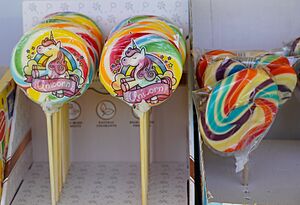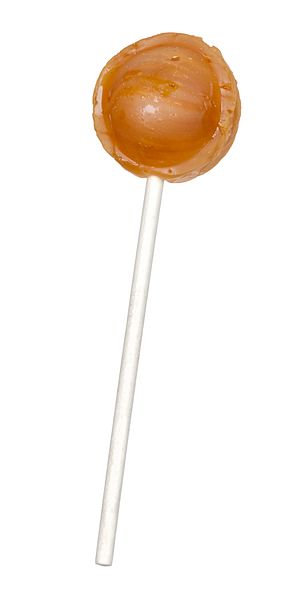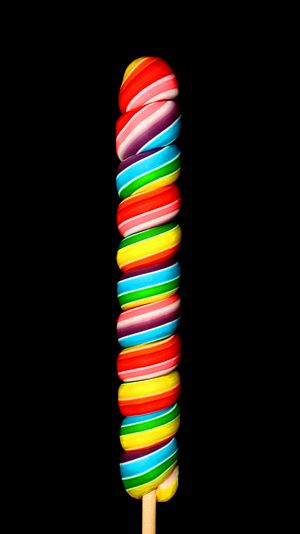Lollipop facts for kids

Rainbow lollipops
|
|
| Alternative names | Lolly, sucker, sticky-pop |
|---|---|
| Type | Confectionery |
| Main ingredients | Sucrose, corn syrup, flavoring |
| Variations | Ice pops |
A lollipop is a sweet treat made of hard candy on a stick. You can suck or lick it. People call them different names like lolly, sucker, or sticky-pop. Lollipops come in many flavors and fun shapes.
Contents
What Kinds of Lollipops Are There?
Lollipops come in lots of colors and flavors. Fruit flavors are very popular. Many companies make lollipops in dozens of flavors and shapes. They can be tiny candies given out at banks or barbershops. They can also be huge treats made from candy canes twisted into a spiral.
Most lollipops are eaten at room temperature. But there are also "ice lollipops" or "popsicles." These are frozen lollipops made mostly of water. Some lollipops have fillings inside, like bubble gum or soft candy. Some special lollipops have unusual things in them. For example, some have a flashing light inside. In North America, some lollipops even have a small motor that makes them spin in your mouth!
In countries like the Nordic countries, Germany, and the Netherlands, some lollipops taste like salty liquorice.
Lollipops for Medicine
Lollipops can also be used to help people take medicine.
Some lollipops have been sold as diet aids. However, there is no real proof they work for weight loss. Any weight loss might be due to the placebo effect, which means believing something will work can sometimes make it seem like it does. Lollipops with medicine are a good way to give children medicine without a fuss.
Actiq is a strong pain medicine that comes as a lollipop. Its main ingredient is fentanyl. Doctors sometimes give Actiq to patients who have a lot of pain, like from cancer. It helps them control sudden, strong pain.
Who Invented the Lollipop?

The idea of candy on a stick is quite simple. It's likely that lollipops have been invented many times throughout history. The first candies that looked like lollipops were made in the Middle Ages. Rich people would eat boiled sugar using sticks or handles.
The exact invention of the modern lollipop is still a bit of a mystery. Many American companies from the early 1900s claim they invented it. One story says George Smith from New Haven, Connecticut, started making large hard candies on sticks in 1908. He supposedly named them after a racehorse called Lolly Pop. He even trademarked the name "lollipop" in 1931.
The word "lollipop" was first written down by an English writer, Francis Grose, in 1796. The name might come from "lolly" (meaning tongue) and "pop" (meaning slap). The word "lollipop" as we know it today became common in the 1920s. Another idea is that the word comes from the Romani language. In Romani, "red apple" is loli phaba. Romani people traditionally sold candy apples on a stick.
What Are Lollipops Made Of?
The main ingredients in a regular lollipop are sugar and corn syrup. Sugar molecules are like tiny chains of carbon atoms with water molecules attached. When sugar is heated, it changes flavor, color, and smell.
Sugar can form two types of solids: crystalline and glassy amorphous. Lollipops are glassy amorphous solids. This means they are like glass, not like crystals. This happens when sugar solutions are heated to very high temperatures. Almost all the water is removed. The final lollipop has very little moisture, about 1-2%.
To stop the sugar from turning into crystals as it cools, special ingredients are added. These are called inhibitors. Common inhibitors in lollipops include corn syrup, cream of tartar, honey, and butter. These ingredients help keep the lollipop smooth and clear, like glass.
While sugar and corn syrup are key, other ingredients are optional. Things like flavors, colors, and fillings (like bubble gum) can be added. But they are not part of the basic structure of a simple lollipop.
How Are Lollipops Made?
Making lollipops involves a chemical process to create their glassy structure. First, the main ingredients are mixed and heated. The temperature depends on how much mixture there is and what's in it. Many hard candies are heated to about 154 degrees Celsius (310 degrees Fahrenheit).
After heating, the mixture is cooled. As it cools, it becomes a "supersaturated" liquid. This means it has more sugar dissolved than it normally could. The inhibitors stop the sugar from forming crystals. This makes the liquid unstable, because crystallization is usually what sugar wants to do. During cooling, the lollipop goes through a "glass transition" process. This is when it changes from a liquid to a hard, glassy solid.
See also
 In Spanish: Paleta (caramelo) para niños
In Spanish: Paleta (caramelo) para niños


